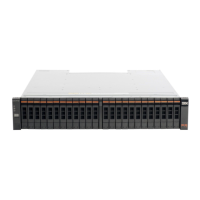The volumes are online. Use the final checks to make the environment
operational; see “What to check after running the system recovery” on page 245.
v
T3 incomplete
One or more of the volumes is offline because there was fast write data in the
cache. Further actions are required to bring the volumes online; see “Recovering
from offline VDisks using the CLI” on page 245 for details.
v
T3 failed
Call IBM Support. Do not attempt any further action.
Run the recovery from any node canisters in the system; the node canisters must
not have participated in any other system.
Note: Each individual stage of the recovery procedure might take significant time
to complete, dependant upon the specific configuration.
Before performing this procedure, read the recover system procedure introductory
information; see “Recover system procedure” on page 240.
1. Enter the service IP address of one of the node canisters.
If the IP address is unknown or has not been configured, assign an IP address
using the initialization tool; see “Procedure: Changing the service IP address of
a node canister” on page 205.
2. Log on to the service assistant.
3. Check that all node canisters that were members of the system are online and
have candidate status.
If any nodes display error code 550 or 578, remove their system data to place
them into candidate status; see “Procedure: Removing system data from a node
canister” on page 204.
4. Select Recover System from the navigation.
5. Follow the online instructions to complete the recovery procedure.
a. Verify the date and time of the last quorum time. The time stamp must be
less than 30 minutes before the failure. The time stamp format is
YYYYMMDD hh:mm, where YYYY is the year, MM is the month, DD is the
day, hh is the hour, and mm is the minute.
Attention: If the time stamp is not less than 30 minutes before the failure, call
IBM Support.
a. Verify the date and time of the last backup date. The time stamp must be
less than 24 hours before the failure. The time stamp format is YYYYMMDD
hh:mm, where YYYY is the year, MM is the month, DD is the day, hh is the
hour, and mm is the minute.
Attention: If the time stamp is not less than 24 hours before the failure, call
IBM Support.
Changes made after the time of this backup date might not be restored.
Verify the environment is operational by performing the checks provided in “What
to check after running the system recovery” on page 245.
If any errors are logged in the error log after the system recovery procedure
completes, use the fix procedures to resolve these errors, especially the errors
related to offline arrays.
244 Storwize V7000 Unified: Problem Determination Guide Version
|
|
|
|
|
|
|

